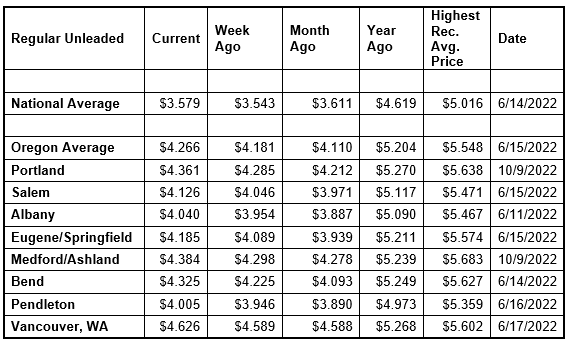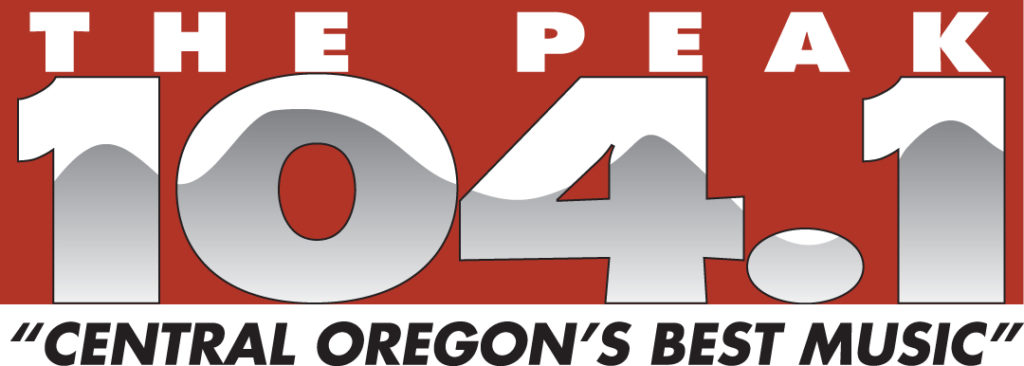The seasonal surge in gasoline demand ahead of the Memorial Day weekend sent pump prices climbing as drivers fueled up for holiday road trips. The deal to raise the nation’s debt ceiling may also bring a rally in oil and gas prices. Still, drivers are saving about a dollar a gallon compared to last year when pump prices skyrocketed above $5. For the week, the national average for regular rises four cents to $3.58 a gallon. The Oregon average adds eight cents to $4.27.

“An increase in demand for gas and a drop in gasoline stocks in the U.S. have put upward pressure on pump prices. Increases are mitigated by relatively low crude oil prices which remain below $75 per barrel. Pump prices should stabilize or even tick lower in the coming weeks,” says Marie Dodds, public affairs director for AAA Oregon/Idaho. “Factors that could push pump prices higher this summer are refinery issues, hurricanes, or major economic or geo-political events.”
OPEC+ is holding its next meeting June 4 in Vienna. At its April meeting, the Organization of the Petroleum Exporting Countries and other major oil producers, including Russia, known collectively as OPEC+, announced that the cartel would cut oil production by just over 1 million b/d through the end of 2023. The news sent oil prices above $80 per barrel, but then crude fell below $80 on April 19 on economic concerns and has remained below $75 per barrel since May 2.
Crude oil is trading around $70 today compared to $73 a week ago and $115 a year ago. In April, West Texas Intermediate ranged between about $73 and $83. In March, WTI ranged between about $64 and $81 per barrel. In February, WTI ranged between about $73 and $80 per barrel. In January, WTI ranged between about $73 and $82 bbl. Crude reached recent highs of $123.70 on March 8, 2022, shortly after the Russian invasion of Ukraine, and $122.11 per barrel on June 8, 2022. The all-time high for WTI crude oil is $147.27 in July 2008.
Crude oil is the main ingredient in gasoline and diesel, so pump prices are impacted by crude prices on the global markets. On average, about 56% of what we pay for in a gallon of gasoline is for the price of crude oil, 20% is refining, 11% distribution and marketing, and 14% are taxes, according to the U.S. Energy Information Administration.
Demand for gasoline in the U.S. demand increased from 8.91 to 9.43 million b/d for the week ending May 19. Rising demand has helped to boost pump prices. This compares to 8.80 million b/d a year ago. Meanwhile, total domestic gasoline stocks decreased by 2 million bbl to 216.3 million bbl. If gas demand grows amid tighter supplies, drivers will likely see pump prices rise.
Quick stats
Oregon is one of 41 states and the District of Columbia with higher prices now than a week ago, and 46 states and D.C. saw prices change by a dime or less in the last week. New Jersey (+14 cents) has the largest weekly increase. Arizona (-9 cents) has the largest weekly decline. The averages in Kentucky and Georgia are flat.
California ($4.86) has the most expensive gas in the nation for the 13th week in a row. Hawaii ($4.74) is second, Washington ($4.69) is third, Arizona ($4.52) is fourth, Nevada ($4.28) is fifth, Oregon ($4.27) is sixth, and Utah ($4.07) is seventh. These are the seven states with averages at or above $4 a gallon. This week 42 states and the District of Columbia have averages in the $3-range. One state, Mississippi ($2.99) has an average in the $2 range this week, same as a week ago.
The cheapest gas in the nation is in Mississippi ($2.99) and Texas ($3.12). For the 124th week in a row, no state has an average below $2 a gallon.
The difference between the most expensive and least expensive states is $1.87 this week, compared to $1.83 a week ago.
Oregon is one of 18 states with higher prices now than a month ago. The national average is three cents less and the Oregon average is 16 cents more than a month ago. Utah (+28 cents) has the largest monthly jump. Florida (-23 cents) has the largest month-over-month drop.
All 50 states and the District of Columbia have lower prices now than a year ago. The national average is $1.04 less and the Oregon average is 94 cents less than a year ago. California (-$1.29) has the largest yearly drop. Arizona (-43 cents) has the smallest. A year ago, pump prices were rising rapidly after the start of the Russian invasion of Ukraine.






